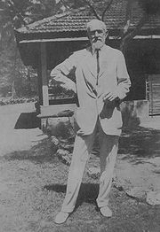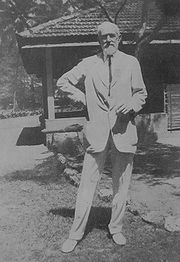
Thomas Reid Davys Bell
Encyclopedia
Thomas Reid Davys Bell born in Bandon, Cork
, was a lepidopterist and forest officer in India
.

Thomas was the youngest in a family of twelve. His early education was in Dresden. He tried to get into the Indian Civil Services but failed. He later wrote entrance exams to Sandhurst and Woolwich, passed but decided not to join the army. He then joined the Indian Woods and Forest Services and joined the services at Dharwad in 1884, as a Deputy Forest Officer. Here he was in touch with Edward Hamilton Aitken
who was in the salt and excise department and James Davidson, collector of the district and along with these keen naturalists he began to study lepidoptera. He also made collections of beetles which he passed on to H. E. Andrewes at the British Museum. He was in Sind between 1905 and 1906 but returned to Belgaum. Davidson had moved back to Edinburgh and he moved to live at Karwar
, North Kanara District, Bombay, India. A series on the common butterflies of India was started in the Journal of the Bombay Natural History Society
by L. C. H. Young, but discontinued due to his ill-health. Walter Samuel Millard
contacted Bell and suggested that he complete the series and Bell reluctantly took up this task. He reared many lepidoptera
specimens from larvae collected in the field and published on a variety of topics including a volume (1937) on the Sphingidae in The Fauna of British India, Including Ceylon and Burma in collaboration with Major F. B. Scott (who was in Assam). In 1911 he was awarded CIE
. He was made a Chief Conservator of Forests, Bombay Presidency in 1913, a position he held until his retirement in 1920. He worked on the grasses of the North Kanara region with L. J. Sedgwick, the collection now at St. Xavier's College in Bombay. Later he also took an interest in the orchids and his sister made illustrations of them. He joined a timber business at Sawanthwadi along with a partner who left him with significant financial losses. In 1930 he gave his entire collection of insects to the British Museum. It had 3000 specimens of butterflies, 12000 moths, 1900 Coleoptera, 1720 Hymenoptera and 20 Orthoptera.
He lived as a bachelor and his sister Eva stayed with him for many years until she died in 1941.
Cork (city)
Cork is the second largest city in the Republic of Ireland and the island of Ireland's third most populous city. It is the principal city and administrative centre of County Cork and the largest city in the province of Munster. Cork has a population of 119,418, while the addition of the suburban...
, was a lepidopterist and forest officer in India
India
India , officially the Republic of India , is a country in South Asia. It is the seventh-largest country by geographical area, the second-most populous country with over 1.2 billion people, and the most populous democracy in the world...
.

Thomas was the youngest in a family of twelve. His early education was in Dresden. He tried to get into the Indian Civil Services but failed. He later wrote entrance exams to Sandhurst and Woolwich, passed but decided not to join the army. He then joined the Indian Woods and Forest Services and joined the services at Dharwad in 1884, as a Deputy Forest Officer. Here he was in touch with Edward Hamilton Aitken
Edward Hamilton Aitken
Edward Hamilton Aitken was a civil servant in India, better known for his humorist writings on natural history in India and as a founding member of the Bombay Natural History Society...
who was in the salt and excise department and James Davidson, collector of the district and along with these keen naturalists he began to study lepidoptera. He also made collections of beetles which he passed on to H. E. Andrewes at the British Museum. He was in Sind between 1905 and 1906 but returned to Belgaum. Davidson had moved back to Edinburgh and he moved to live at Karwar
Karwar
Karwar is the administrative headquarters of Uttara Kannada district in Karnataka, India. It is a seaside town situated on the banks of the Kali river which is on the west coast of the Indian peninsula. The town lies about 15 kilometres south of the Karnataka–Goa border and 519 km north-west...
, North Kanara District, Bombay, India. A series on the common butterflies of India was started in the Journal of the Bombay Natural History Society
Bombay Natural History Society
The Bombay Natural History Society, founded on 15 September 1883, is one of the largest non-governmental organizations in India engaged in conservation and biodiversity research. It supports many research efforts through grants, and publishes the Journal of the Bombay Natural History Society. Many...
by L. C. H. Young, but discontinued due to his ill-health. Walter Samuel Millard
Walter Samuel Millard
Walter Samuel Millard was a British entrepreneur and naturalist who was honorary secretary of the Bombay Natural History Society and editor of the Journal of the Bombay Natural History Society from 1906 to 1920, co-author of the classic, Some Beautiful Indian Trees, and the driving force behind...
contacted Bell and suggested that he complete the series and Bell reluctantly took up this task. He reared many lepidoptera
Lepidoptera
Lepidoptera is a large order of insects that includes moths and butterflies . It is one of the most widespread and widely recognizable insect orders in the world, encompassing moths and the three superfamilies of butterflies, skipper butterflies, and moth-butterflies...
specimens from larvae collected in the field and published on a variety of topics including a volume (1937) on the Sphingidae in The Fauna of British India, Including Ceylon and Burma in collaboration with Major F. B. Scott (who was in Assam). In 1911 he was awarded CIE
Order of the Indian Empire
The Most Eminent Order of the Indian Empire is an order of chivalry founded by Queen Victoria in 1878. The Order includes members of three classes:#Knight Grand Commander #Knight Commander #Companion...
. He was made a Chief Conservator of Forests, Bombay Presidency in 1913, a position he held until his retirement in 1920. He worked on the grasses of the North Kanara region with L. J. Sedgwick, the collection now at St. Xavier's College in Bombay. Later he also took an interest in the orchids and his sister made illustrations of them. He joined a timber business at Sawanthwadi along with a partner who left him with significant financial losses. In 1930 he gave his entire collection of insects to the British Museum. It had 3000 specimens of butterflies, 12000 moths, 1900 Coleoptera, 1720 Hymenoptera and 20 Orthoptera.
He lived as a bachelor and his sister Eva stayed with him for many years until she died in 1941.

